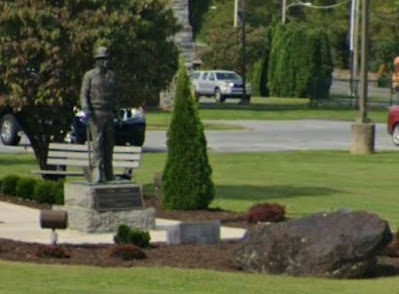Honoring the Cornwall Miner
If you are that person who is unaware, a very short distance from the statue is what remains of the largest open pit iron mine in the western hemisphere in the 18th century. It is now a "lake," which you may have noticed while driving out Boyd Street into Miners village. The Cornwall Ore Bank is the reason we have the Cornwall Iron Furnace, and so many beautiful historic buildings, and a former multi-generational family whose wealth contributed so much to the growth of Lebanon County.
The bronze miner stands to remind us that the iron hidden in the Ore Bank did not just jump out of the ground and morph itself into railroad rails and bridge trusses and 10-plate stoves and frying pans. No, indeed; it took lifetimes of hard manual labor. It took the sweat of men and of mules, and the hard lives of families whose existence depended on breaking the ground and digging rock to move a nation forward into the times of ease that we now enjoy.
I confess I have suffered a dismissive thought, "how nice to erect a statue in memory of the miners" before grasping the far greater significance of this simple, humble bronze casting.
The statue was installed and dedicated Sunday December 5, 1993 over 20 years after the mine had ceased from 231 years of operation. Accompanying the statue is a large 7,230 pound piece of magnetite ore donated by Superintendent Mel Lipensky.This memorial was erected by the Cornwall Miners Association, who wanted to make sure that all that the mine signifies is preserved in our memories. The 5 foot 8 inch statue seems small, out of proportion to the vast mountain of rock that had been moved over so many years, but what other symbol might one choose than a solitary man equipped for his labor?
 The statue was cast in bronze at Art Research and Technology Ltd, in Lancaster. Adams Brothers contractors of Jonestown did the stonework and mounting. The plaque came from Zimmerman's Foundry in Columbia. The land contributed by the Cornwall-Lebanon School District. The $27,000 cost was sustained by the contributions of former mine workers and their families, businesses in the Cornwall and Lebanon areas, a contribution from Bethlehem Steel, and state-allocated funds arranged for by Senator David Brightbill and Representative Peter Zug at the request of Lebanon County Commissioner William Carpenter.
The statue was cast in bronze at Art Research and Technology Ltd, in Lancaster. Adams Brothers contractors of Jonestown did the stonework and mounting. The plaque came from Zimmerman's Foundry in Columbia. The land contributed by the Cornwall-Lebanon School District. The $27,000 cost was sustained by the contributions of former mine workers and their families, businesses in the Cornwall and Lebanon areas, a contribution from Bethlehem Steel, and state-allocated funds arranged for by Senator David Brightbill and Representative Peter Zug at the request of Lebanon County Commissioner William Carpenter.
But Wait, There's More...
Of late the Cornwall Iron Furnace has been interviewing several miners as part of a Living History video project. You will enjoy hearing these life stories told in the first-person; look for them at the Iron furnace website!
One particular interview is with retired miner Frank Stellar, and among the stories he tells in the video are some pictures he shared. Here are two in which he had participated in the dedication of the monument.

And More...
The 1993 bronze statue was not the first of its type. Preceding it by just a few years was a wooden statue, carved by Brian Ruth from a log in June 1990. As shown in this photo, it was located at the Miners village Store.
The man who had the sculpture commissioned gave it away as payment for a gambling debt. The carving went to Lancaster County, where it was to be displayed in a
restaurant, but ultimately cut up for fire wood.







Comments